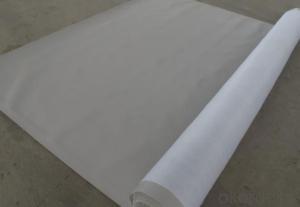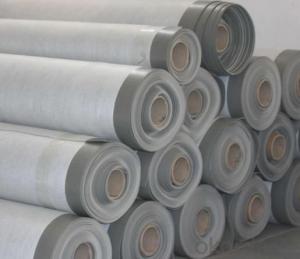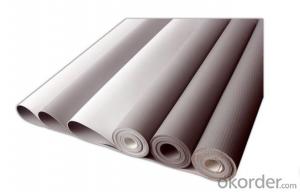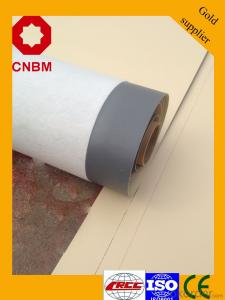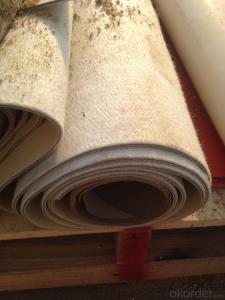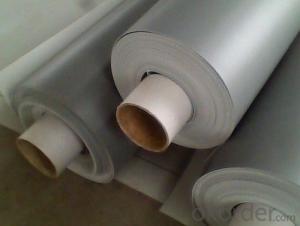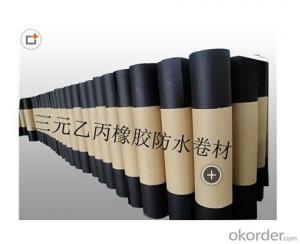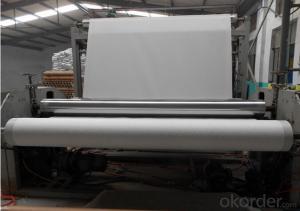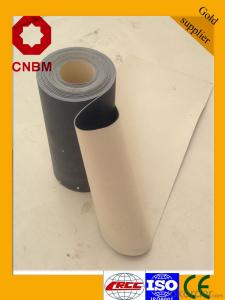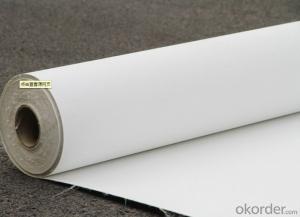Durable PVC Waterproofing Membrane for Roofing
- Loading Port:
- China main port
- Payment Terms:
- TT OR LC
- Min Order Qty:
- 5000 m²
- Supply Capability:
- 100000 m²/month
OKorder Service Pledge
OKorder Financial Service
You Might Also Like
Introduction of PVC Waterproofing Membrane:
Polyvinyl Chloride (PVC) waterproof membrane is a new polymer waterproof membrane. The raw material is polyvinyl chloride resin, mixed with plasticizer, filler, antioxygen, ultraviolet absorber and other auxiliaries.
Specification of PVC Waterproofing Membrane:
No. | Item | Model Ⅱ | |
1 | Tensile Strength Mpa ≥ | 12.0 | |
2 | Elongation at break% ≥ | 250 | |
3 | Shrinkage rate % ≤ | 2.0 | |
4 | Flexibility at low temperature | No crackle at -25oC | |
5 | Water tightness | Watertight | |
6 | Puncture resistance | Watertight | |
7 | Heat aging treatment | Appearance | Free from bubble, crack, cohesion and void |
Change rate of tensile strength % | +20oC | ||
Change rate of elongation at break | |||
Flexibility at low temperature | No crack at -20oC | ||
8 | Chemical corrosion resistance | Change rate of tensile strength % | +20 |
Change rate of elongation at break | |||
Flexibility at low temperature | No crack at -20oC | ||
9 | Artificial weathering | Change rate of tensile strength % | +20 |
Change rate of elongation at break | |||
Flexibility at low temperature | No crack at -20oC | ||
Remark: The property of artificial weathering might not be applicable to non-exposed product | |||
Product Features:
a) High Strength
b) Hot-air welded seams for long-term performance
c) Proven membrane performance
d) Excellent resistance to plasticizer extraction and migration performance.
Physical Property
1. Exposed to sunshine: UV rays resistance, long service life and aging resistance
2. Easy installation and dimensional stability: can be wieldable under wide range of temperature and experience minus dimensional change in thermal treatment
3. High tensile strength and elongation thus can accommodate movements of substrates
4.Good flexibility under low temperature, good adaptability to ambient temperature difference
5, Secure anti-puncture and good rooting resistance, no pollution caused to environment when being welded and good waterproofing choice for plant roofs
6. Good plasticity: convenient and fast treatment of detailed parts of corners and edges
Product usage
a) Roofing (covered & exposed roofs)/ Re- roofing
b) Tunnel Lining
c) Tanking of Underground structures
d) Lining of evaporation ponds & artificial lakes
e) Lining of drinking water tanks & swimming pools
f) Agricultural purposes & Lining of irrigation canals
FAQ of PVC Waterproofing Membrane
a.Can we get some samples before place order?
Answer: We can send the free samples to you by freight collect.
b.How many years can your PVC membrane guarantee?
Answer: We will guarantee the quality for 5 years at least.
c.Which countries you ever export the product?
Answer: We export the PVC membrane to South Africa, Middle east and even European countries.
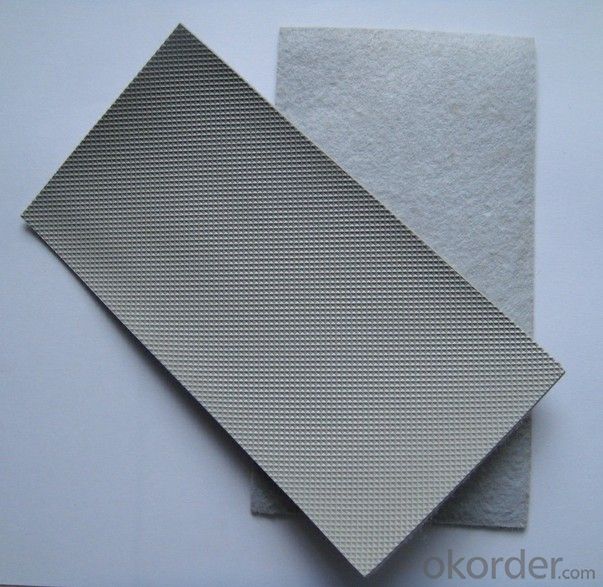
- Q: Can a waterproofing membrane be used on precast lead surfaces?
- Precast lead surfaces can benefit from the application of a waterproofing membrane. These membranes are commonly used to safeguard various types of surfaces, such as precast concrete, metal, or lead surfaces. By forming a reliable barrier against water penetration, these membranes effectively keep the underlying structure dry and well-protected. To achieve optimal results, it is crucial to thoroughly clean, dry, and remove any contaminants from the precast lead surface before applying the waterproofing membrane. This step promotes proper adhesion and enhances the membrane's ability to prevent water infiltration. For specific guidance on using a waterproofing membrane on precast lead surfaces, it is advisable to seek professional advice or consult the manufacturer's guidelines.
- Q: What is the preferred level of waterproofing?
- , roof level 1 waterproof: Application: particularly important or waterproof with special requirements of the building; Waterproof layer of reasonable use of life: 25 years; Waterproof layer selection of materials: should use synthetic polymer waterproofing membrane, polymer modified asphalt waterproofing membrane, metal sheet, synthetic polymer waterproof coating, fine stone concrete and other materials; Fortification requirements: three or more than three waterproof fortification.
- Q: Can a waterproofing membrane be used for theaters or concert halls?
- Theaters and concert halls can benefit greatly from the use of waterproofing membranes. These membranes are commonly employed in construction projects to safeguard buildings against water damage by preventing water infiltration. They are applied to various surfaces, including walls, floors, and roofs, creating a barrier that stops water from seeping through. In the case of theaters and concert halls, where the protection of the building structure and equipment is of utmost importance, waterproofing membranes can be extremely advantageous. They play a crucial role in preventing water damage to delicate equipment like audiovisual systems, lighting fixtures, and musical instruments. Furthermore, these membranes ensure a dry and comfortable environment for both performers and audience members by preventing water leakage and moisture buildup. In conclusion, the use of a waterproofing membrane in theaters or concert halls guarantees the longevity and functionality of the building, creating a safe and enjoyable experience for all involved.
- Q: How does a waterproofing membrane handle seismic movements?
- A waterproofing membrane is designed to be flexible and able to withstand seismic movements. It is typically made of materials such as rubber or modified bitumen that have high elongation properties, meaning they can stretch and move with the building during an earthquake without tearing or breaking. This flexibility allows the membrane to remain intact and maintain its waterproofing capabilities even when subjected to significant seismic movements.
- Q: Can a waterproofing membrane be used for a parking garage deck?
- Yes, a waterproofing membrane can be used for a parking garage deck. A waterproofing membrane is a barrier that is designed to prevent water from penetrating into the underlying structure. In the case of a parking garage deck, which is exposed to various weather conditions and potential water leaks from vehicles, a waterproofing membrane can help protect the concrete slab and prevent moisture-related issues such as cracking, corrosion, and deterioration. By applying a waterproofing membrane to the parking garage deck, it creates a protective layer that prevents water from seeping into the concrete. This membrane can be applied as a liquid coating, sheet membrane, or a combination of both. The choice of membrane will depend on factors such as the desired level of protection, the traffic load, and the specific requirements of the project. In addition to preventing water penetration, a waterproofing membrane for a parking garage deck can also have other beneficial properties. Some membranes are designed to be resistant to chemicals and oil, which is important considering the potential exposure to vehicles. They can also provide an added layer of protection against freeze-thaw cycles, which can cause damage to the concrete structure. It is worth noting that the installation of a waterproofing membrane for a parking garage deck should be done by experienced professionals, following the manufacturer's guidelines and industry standards. Proper surface preparation, including cleaning and repairing any cracks or defects, is crucial for ensuring the long-term effectiveness of the membrane. In summary, a waterproofing membrane can be an effective solution for protecting a parking garage deck from water damage. It helps to prevent water penetration, protects the concrete from deterioration, and can enhance the overall durability and lifespan of the structure.
- Q: Are there any specific considerations for installing a waterproofing membrane on wood surfaces?
- Yes, there are several specific considerations for installing a waterproofing membrane on wood surfaces. Firstly, it is important to ensure that the wood surface is clean, dry, and free from any debris or loose material. This will help in achieving a proper adhesion of the waterproofing membrane. Additionally, it is crucial to choose a membrane specifically designed for wood surfaces, as they may require additional flexibility and resistance to expansion and contraction. It is also recommended to apply a primer or sealer to the wood surface before installing the membrane to improve its adhesion and longevity. Lastly, regular inspection and maintenance of the waterproofing membrane is essential to identify any potential issues and ensure its effectiveness over time.
- Q: Can a waterproofing membrane be used in foundations?
- Foundations can benefit from the use of a waterproofing membrane. Installing such a membrane is often recommended to prevent water infiltration and protect the structure from potential damage. This barrier is typically applied to the exterior walls of the foundation, effectively blocking water penetration. By keeping the foundation dry, it safeguards against cracks and leaks caused by hydrostatic pressure. Moreover, a waterproofing membrane helps prevent moisture buildup, mold growth, and other water damage-related issues. Overall, incorporating a waterproofing membrane in foundations is a dependable and effective approach to ensure the long-lasting stability and durability of a building.
- Q: Can a waterproofing membrane be used on tunnels with ventilation systems?
- Tunnels with ventilation systems can indeed utilize a waterproofing membrane. It is highly advisable to incorporate such membranes in these tunnels to avoid water infiltration and potential harm to the tunnel structure and ventilation system. The presence of a waterproofing membrane will establish a barrier that hinders water from seeping into the tunnel, thereby preserving its integrity and shielding the ventilation system from water-related problems like corrosion or moisture accumulation. Moreover, the use of a waterproofing membrane can aid in upholding the efficiency and effectiveness of the ventilation system by preventing moisture or water vapor from entering the tunnel, which could lead to condensation or the growth of mold. All in all, incorporating a waterproofing membrane in tunnels with ventilation systems is a vital measure in guaranteeing the long-term durability and functionality of both the tunnel and its associated ventilation system.
- Q: Are waterproofing membranes resistant to root penetration?
- Yes, waterproofing membranes are generally resistant to root penetration. These membranes are specifically designed to prevent water from penetrating through the surface and into the underlying structure. In addition to their water resistance, they also possess qualities that make them resistant to root penetration. This is important in areas where vegetation or trees may be present, as roots have the potential to grow and penetrate through various surfaces, causing damage and compromising the integrity of the waterproofing system. Waterproofing membranes are typically made from materials that are tough and durable, providing a barrier that roots cannot easily penetrate. However, it is important to note that no waterproofing membrane is completely immune to root penetration, as some root systems may be particularly aggressive or invasive. In these cases, additional measures such as root barriers or specialized membranes may be necessary to ensure long-term protection against root penetration.
- Q: Can a waterproofing membrane be applied to wood surfaces?
- Yes, a waterproofing membrane can be applied to wood surfaces. There are various types of waterproofing membranes available on the market, such as liquid membranes or sheet membranes, that can be specifically designed for wood surfaces. These membranes are typically made of materials like rubber, asphalt, or polyurethane, which provide a protective barrier against water and prevent moisture from penetrating the wood. The waterproofing membrane is applied to the wood surface using different methods, depending on the product, such as brushing, rolling, or spraying. Applying a waterproofing membrane to wood surfaces can help prolong the lifespan of the wood, prevent rotting or warping, and protect it from water damage. However, it is important to ensure proper surface preparation and follow the manufacturer's instructions for application to achieve the best results.
Send your message to us
Durable PVC Waterproofing Membrane for Roofing
- Loading Port:
- China main port
- Payment Terms:
- TT OR LC
- Min Order Qty:
- 5000 m²
- Supply Capability:
- 100000 m²/month
OKorder Service Pledge
OKorder Financial Service
Similar products
Hot products
Hot Searches
Related keywords
